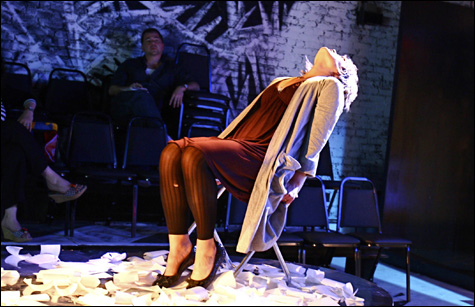
EVERYPERSON: Elise Morrison as “Her” |
Sweet Disaster, the earthquake of a play by Charlotte Meehan that’s getting its world premiere at Perishable Theatre through May 11, may not topple any of our convictions about how the world works. But that’s only because it reminds us how we stumble over our existential rubble every day.
Directed with great imagination by Ken Prestininzi, its 90 minutes simulate the precarious human condition — our neurotic Western mode, anyway — in all its frenetic, inchoate glory. Linear, kitchen-sink narrative this ain’t.
And neither is it the sort of free-association hodgepodge that can pass for avant-garde. While the play is poetical, Meehan quickly proves artful, not arbitrary. And darkly humorous, while she’s at it.
The characters are listed by letters instead of names, since they represent us instead of themselves. The exception is Elise Morrison, identified as “Her,” an Everyperson we see in conditions from near catatonia to portraying a newscaster describing a natural disaster. The actors in this skillful ensemble add layers to the characters they establish in early conversation. Elizabeth Anne Keiser, as someone recently damaged by love: “How will I know I’m alive if no one is looking at me?” Gloria Crist, asked how she copes: “I pretend to be an heiress.” Luis A. Astudillo: “Strange things are happening all the time and we don’t even notice.” And R. Bobby, as a man stifling anger, clenching and unclenching like a fist.
After a wordless scene of the six characters in an art gallery, the play starts off with a group therapy session in which we glimpse people with various addictions — to sex, drugs, rage, etc. In other words, if art can’t cure us, maybe we should give talking a shot. Periodically the therapy continues, but fractured conversations and monologues also take place in settings as diverse as a church, a hospital, and a car dealership. Someone at an insurance company reads off contractual descriptions of what constitutes dismemberment. A woman chipperly instructing a real estate license class loses her temper as they ignore her. Silent short films by David Hopkins are background, some abstract and one a domestic drama with mouthless puppets.
The audience sits in bleachers on opposite sides of the performance space, as though on display to each other. The scenic design by Sara Ossana is a raised platform covered with torn paper and, at first, two folding chairs at opposite ends, signaling confrontation. The black walls surrounding us are painted with white shards, the geometry of shattered mirrors. Panels in similar shapes function as a screen for Hopkins’s projections.
Many of those jagged shapes will be removed by the conclusion of the play and tossed onto the tumultuous action’s plentiful debris. By that point, as far as the characters are concerned, inside and outside have largely exchanged places. What was an orderly exterior is now a mess, and their inner confusions have more or less calmed down.
It’s as though these people are now able to see the disorder around them, which has always been there but which they’ve been too absorbed to notice. That need to notice what’s around us is a recur-ring theme, though we’re not pestered with it. Early on, a man sees his hand, its detail and complexity, as though for the first time. That reminder eventually takes on the import of Linda’s “attention must be paid!” praise of Willy Loman in Death of a Salesman.
The sweet part of Sweet Disaster is its concluding affirmation, quite earned by the end and thereby not sentimental. Someone observes that a loved one is a baffling gift that makes worthwhile the bruises and breakage of clambering about the wreckage around us. No, this is not one of those insightful dramas whose subtext invites us to slash our wrists afterwards. That call to love — don’t worry: it’s in the context of a death, so you don’t have to be embarrassed — comes after we are softened by an abrupt but fitting change of tone. To joy. The characters grin and start stripping; but no, it’s not an orgy, it’s a day at the beach, with swimming togs and gear and lots of wordless, thought-free play.
Sweet Disaster requires close attention, which is part of its point. The play isn’t as coherent as it could be — and should be, I’d suggest, since it presents arguments as well as evocative poetry. But it’s frequently thought-provoking and always unpretentiously urgent, which makes it well worth seeing.